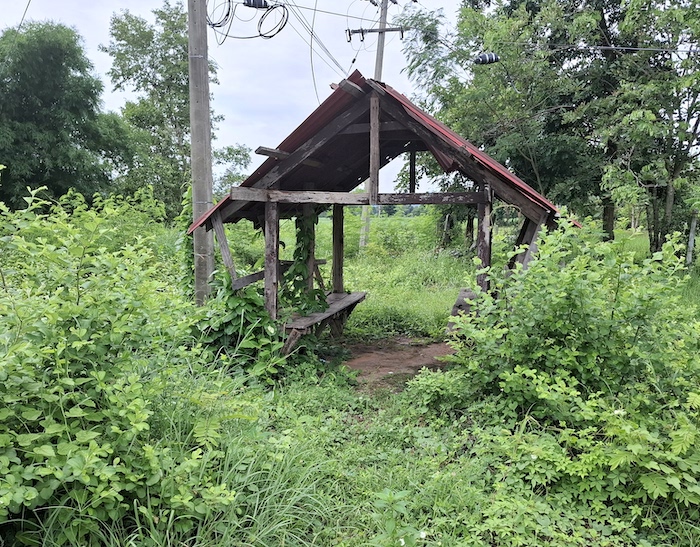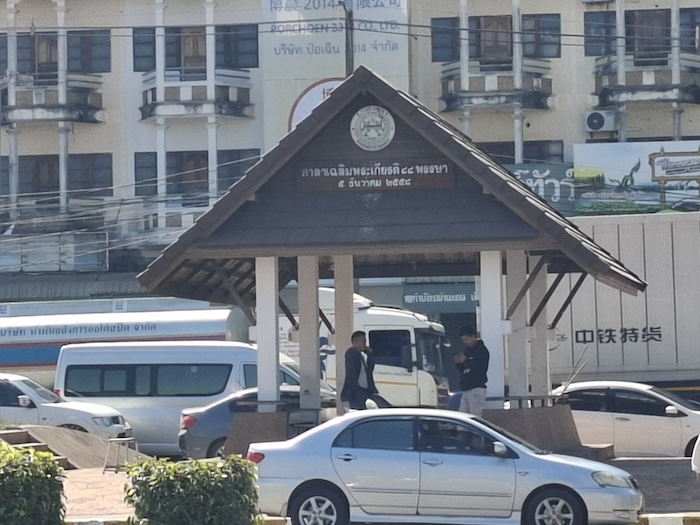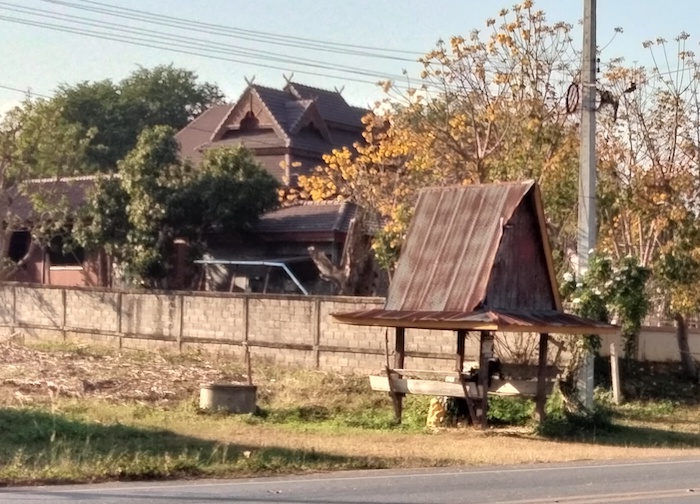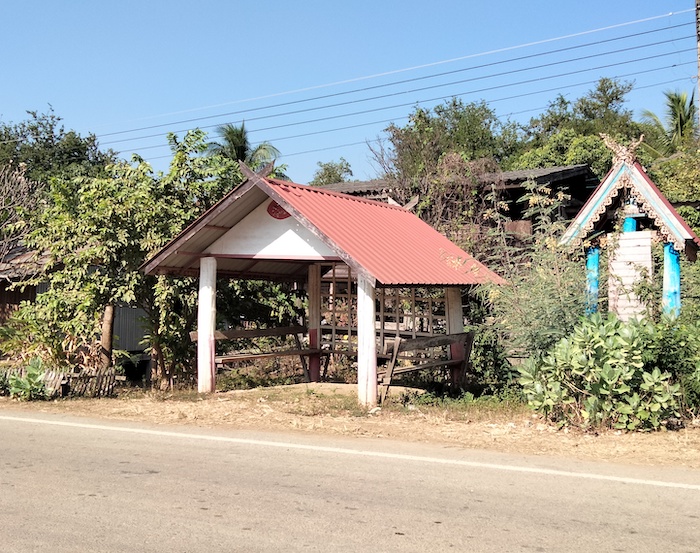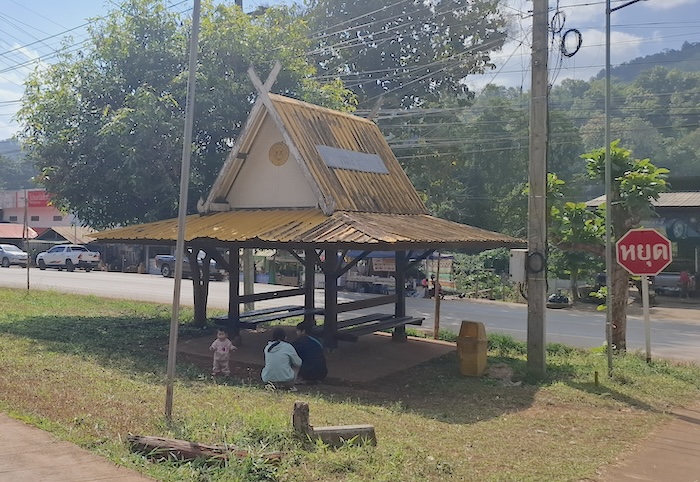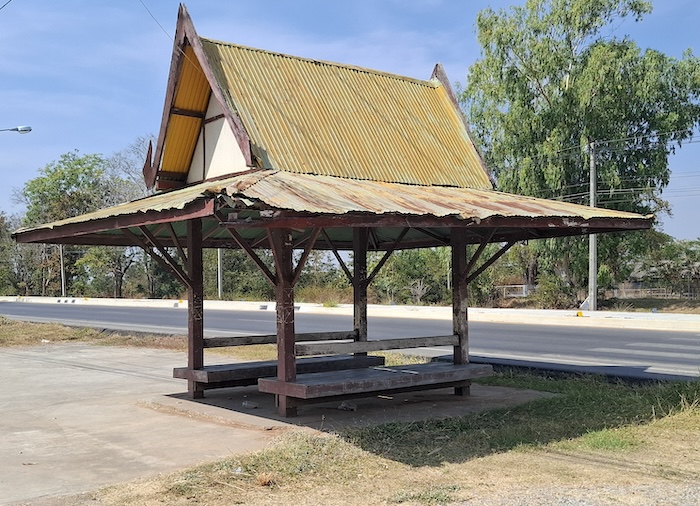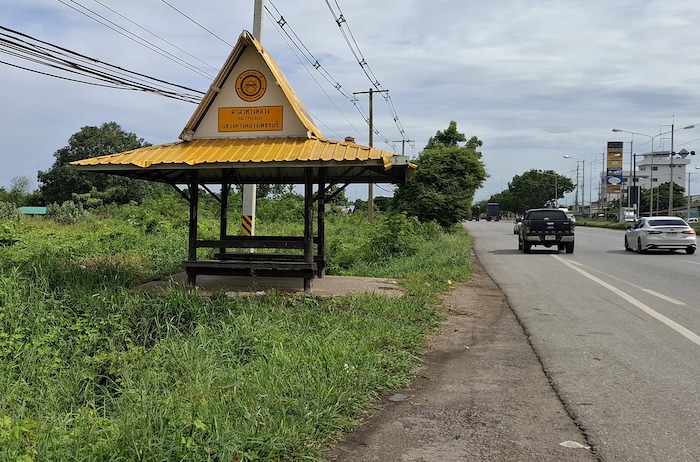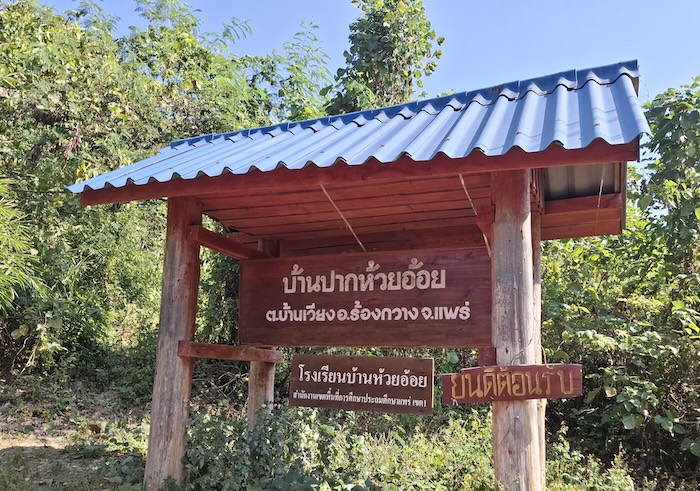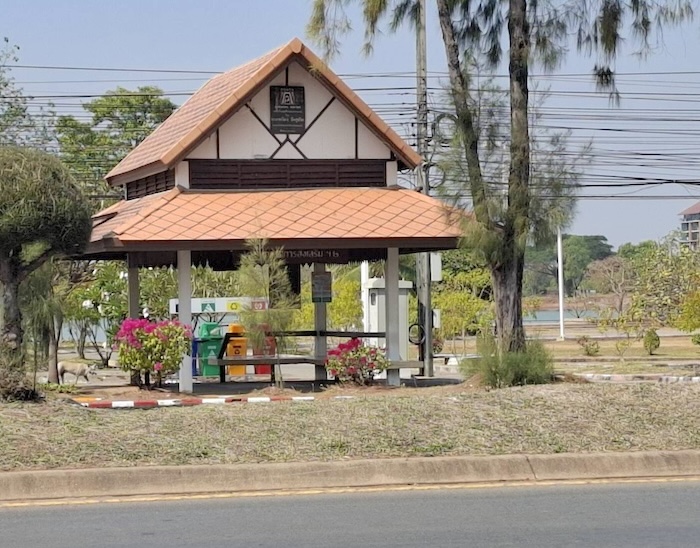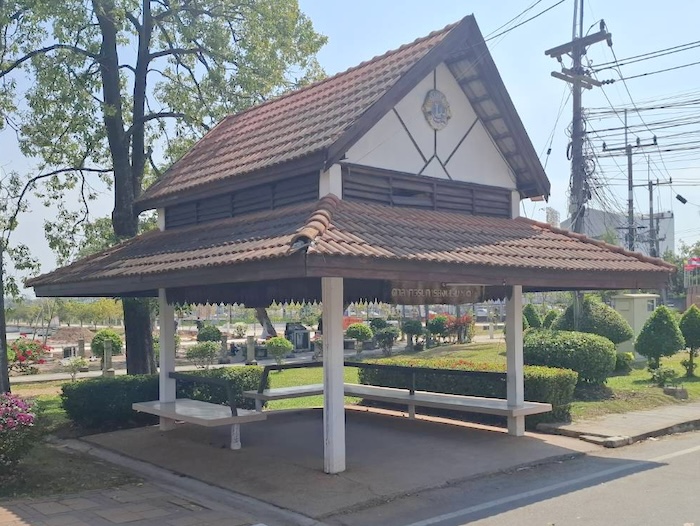These constructions, seen all over Thailand, are known as roadside shelters or ‘highway huts’. They are sometimes referred to as bus shelters/stops, however, only in Bangkok, where there are 2100 modern, differently designed structures, are they actually used as bus stops.
Songtaews (it could be argued that these are buses in Thailand) sometimes use them as a pickup point.
They are used as a resting place, a meeting place, a garage, as a shelter for the homeless or simply not used at all. Many are located arbitrarily and even injudiciously, although that should not be cause for too much comment in Thailand. An indeterminate number are constructed merely to expend the end-of-year budget. The are not built by a single entity.
The type of construction varies, as does the colour, the design, the finish and the utility. One obvious feature – the colour – changes by locale. The most common colour is yellow but red, blue and green are also seen.
In more populated areas there are sometimes up to three in a kilometre. In more rural areas they are more spaced or non-existent.
Roadside Shelters/Highway Huts are an interesting reflection of the various communities within Thailand, and their culture.
Ongoing construction and refurbishment of these shelters indicates that they are a required and even desired facility.
They are sometimes provided by community-minded corporations like Big C in Ayutthaya that funded this one on the busy highway in front of their complex.
- Provided by Big C, Ayutthaya.
Or this one on Route 11 at Ban Khao Taphan Nak, Phitsanulok provided by Akara Resources, owner of the Chatree Gold Mine – Thailand’s largest.
- Provided by Akara Resources.
Or this one outside Ban Kok Mai Daen, provided by the local Police Social Club.
- Outside Ban Kok Mai Daen. Provided by the local Police Social Club.
There are numerous benefactor-provided roadside shelters throughout the country.
However, by far the great majority of roadside shelters are provided by the Department of Highways, an agency of Thai government that, refreshingly, has a ‘No Gift Policy”. They are responsible for more than 25,000 shelters nationwide. The design of these shelters, while not uniform, is distinctive.
- Department of Highways’ shelter at Nong Bua Lamphu.
- This shelter was built by the Department of Highways. The numbers indicate distance from a certain point.
The Department clearly has a program to replace/update shelters throughout the country but equally clearly the program is not keeping pace or certain sites are falling off the radar. In 2018 they spent 200 million baht replacing and refurbishing roadside shelters.
The constructions range from modern shelters in good condition to decrepit structures of historical value only.
- Close to the road.
- Roof colour varies depending on location and which agency constructed the shelter.
- The tiled roof, while not unique, is unusual.
- Different style.
- Just north of Ban Tao in Chaiyaphun Province.
- On Route 4003, Ta Kon, Si Sa Ket.
- At Khamcha-I, Mukdahan Province.
- In Ban Na Wang, western Nong Bua-Lamphua.
- In Ban Mai Thong, Prasoet, Phitsanulok.
- Nong Bua Lamphu.
- Mueang Phia, Khon Kaen.
- The Highway Department erected two shelters outside their depot at Mae La Noi, Mae Hong Son Province.
- At Ban Tha Song Khwae, Route 108 midway bewteen Mai Sariang and Khun Yuam
- On Route 1349 past Ban Mae Ta La, Chiang Mai Province.
- On Route 108, just north of Mai Sariang.
This Roadside Shelter at Ban Pak Huay Oi Tai was erected in memory of a respected villager.
- Highway Hut Ban Pak Huay Oi Tai in Phrae.
- Erected in memory of a respected villager.
- Road in to Khon Kaen University.
- Road out of Khon Kaen University.
This Roadside Shelter at Chong Khae actually declares its identity as a ‘Highway Hut’.
- On Route 11 at Chong Khae, Nakhon Sawan.
- Literal translation from Thai to English is “highway hut”.
- On Route 108 between Mai Sraiang and Khun Yuam.
- On the road through Khun Sathan National Park.
- Nong Pla Buek on Route 211 along the Mekong River.
- Near Friendship Bridge, Nong Khai.
- Between Phrae and Nam Pat.
- Three substantial shelters.outside Samakhi Witthayakhom Song School in Chiang Rai.
- Unusually-steep-sided roof.
- In Nan.
- Fairly typical of these shelters.
- This well-maintained shelter is located underneath a saphanloy (pedestrian flyover).
- Same shelter under the saphanloy.
- Tan Lian Municipality
- Modern structure on Route 202, Pho Sai, Yasathon. Its design and inner city location suggests that it may be, indeed, be a Bus Stop.
- Ban Thin, Phrae Province.
- Ban Tha Song Khwae, Route 108 midway between Mai Sariang and Khun Yuam.jpg.
- Ban Pak Rong, Phitsanulok Province.
- Ban Pa Daet, Chiang Mai.
- Ban Mae Sap Nuea, Chiang Mai.
- Ban Huai Thap Chang, Loei Province on Route 211.
- In Nam Phat, Uttradit.
- On Route 2 (Mittraphap Road) in Non Ta Then, Korat.
- Built over a drain
- In Phitsanoluk.
- Not used every day.
- On Route 2381, Maha Sarakham.
- While still a shelter it varies in design from most.
- On Rural Road 2389, Chaiyaphun Province.
- Route 2269, Pathum Rat, Roi Et.
- On Route 210, Nong Bua Lamphua.
- Disused shelter near the Friendship Bridge in Nong Khai.
- At Viewpoint looking towards Tha Li in Loei Province.
- At Chiang Khan Skywalk.
- At Pangmapha between Pai and Ban Wat Chan.
- At Chat Trakan, Phitsanulok.
- Outside the Khon Kaen College of Agriculture and Technology.
- Obviously the Nong Waeng community see this as an unnecessary construction. One of those end of budget follies – although probably not considered as such by the team commissioned to build it.
- Another Department of Highways shelter with distance shown.
- A larger than normal shelter in Nong Bua Lum Phu. Its location on the right side of the road (fastest traffic) is bizzare.
- Outside the Khon Kaen College of Agriculture and Technology.
- On Phetkasem Road, Tha Yang District, Petchaburi.
- Suranarai Road, Chaiyaphun Province.
- Route 202, Kaset Wisai.
- Unusual, if not unique, at Nong Bua Lamphu. More obviously a ‘bus stop’.
This is an interesting juxtaposition of Shelters on Route 2269. The newer green structure in the first photograph has clearly replaced the ageing yellow hut. Immediately opposite, on the other side of the road, in the second photograph, is an even newer structure – but this is in Maha Sarakham Province. Obviously Route 2269 is the border between the two Provinces in this location. Note the color change of the roofs from yellow to green. This is also seen in the green-roofed shelter at Pathum Rat, Roi Et (above).
- Route 2269, Roi Et.
- On Route 2269. Although opposite the two shelters in Roi Et (shown above), this shelter is in Maha Sarakham.
- Nong Chim in Nong Bua Lamphu
- In front of Wat Pa Si Udom Phon, Khon Kaen.
- In front of Wat Pa Si Udom, Phon Khon Kaen.
- Ban Na Dokmai Kham Pia Don Kha Khon Kaen.
- Ban Pak Huay Oi-Tai
- Entrance to Khon Kaen uNiversity
- Exit from Khon Kaen University.
© Kim Epton 2024-2025
1146 words, 71 photographs.
Feel free to use any part of this document but please do the right thing and give attribution to adventures.net.au. It will enhance the SEO of your website/blog and Adventures.
See Terms of Use.










